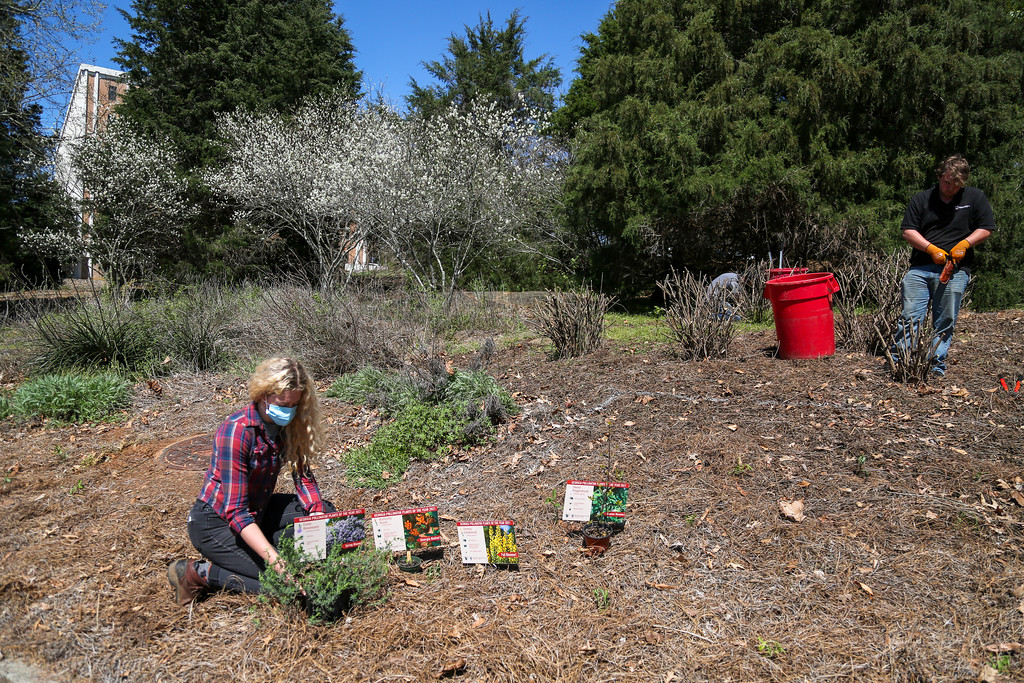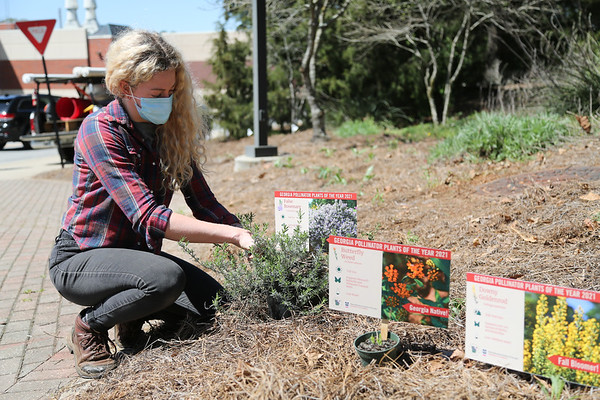The buzz around UGA this spring is coming from East Campus Road and Sanford Drive.
That’s where bees, butterflies and other insects are gathering around new pollinator plant beds installed to raise awareness of importance of native plants, as well as draw attention to the university’s recent Bee Campus USA designation.
“Of course we want a beautiful landscape with lots of flowers. We can have that and also support wildlife in a big way,” says Lauren Muller, conservation outreach coordinator for the State Botanical Garden of Georgia. “We want to teach people that even a small garden can make a difference, because we’re connecting patches of habitat throughout urban and suburban areas through which insects and birds can move and find shelter and food.”

At the Mimsie Lanier Center for Native Plant Studies, Lauren Muller helps the grounds crew. (Photo by Shannah Montgomery)
Muller, working with the UGA Facilities Management Division, installed garden beds with native pollinator plants—including the garden’s Georgia Pollinator Plants of the Year—on land at East Campus Road and Carlton Street, and on Sanford Drive next to the Tate Center.
“We’re hoping that people start to think more about the ways that their landscapes can and should function,” Muller says.
In March, UGA was officially recognized as a Bee Campus by the Xerces Society for Invertebrate Conservation. The designation means that UGA has demonstrated a commitment to enhance and promote pollinators on campus.
The process to become a Bee Campus USA was launched with the establishment of the UGA Campus Pollinator Committee formed in 2019 with representatives from the State Botanical Garden, a UGA Public Service and Outreach unit, as well as UGA entomology and horticulture experts, university landscapers and grounds crew.
Coordinated by Tyra Byers, director of the Interdisciplinary Sustainability Certificate, the goal was to bring together a cross section of university experts to increase opportunities for research, experiential learning and sustainability efforts at UGA.
“We see campus as a living laboratory, so we would like for there to be opportunities for public service and outreach—where we’re using the grounds to teach and educate and engage people with these resources,” Byers said. “We have a number of classes that are using the grounds for experiential learning opportunities. We want to know how we can enhance and highlight and pilot things here to see if they can be expanded and shared elsewhere.”
Muller and Steve Mitchell, a UGA landscape architect, developed the plan to bring the botanical garden’s Georgia Pollinator Plants of the Year (GPPY) to campus. The 2021 plants, which are selected for their value toward pollinators as well as for their beauty and ease of care, include false rosemary, sweet pepper bush, downy goldenrod and butterfly weed.
GPPY was launched last year at the State Botanical Garden, in partnership with UGA Extension, Georgia Green Industry Association and the Georgia Department of Natural Resources, to encourage growers to produce more Georgia native pollinator plants and encourage consumers to incorporate them into their gardens. Four GPPY are selected each year, one for each category: Spring Bloomer, Summer Bloomer, Fall Bloomer and a Georgia Native.
“We’ve got hundreds of acres of landscapes and seeing that there was this effort at having pollinator plants on campus, it just seemed like a good idea and it just kind of worked itself out organically,” Mitchell said. “There is a movement of sorts to be more conscious of our pollinators and to provide habitat [for them]. We are huge fans of the botanical garden and the Mimsie [Lanier] Center [for Native Plant Studies], and anything we can do to help strengthen our partnership, we’re all for it.”
You can learn more about the Campus Pollinator Project at https://sustainability.uga.edu/community-engagement/pollinators, where you can also view an interactive map of pollinator locations on campus.

